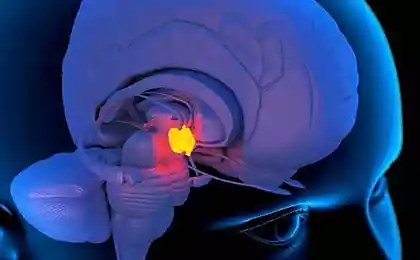553
Programming the universe: from the sexual revolution to the quantum computer
Sixty seven million thirteen thousand three hundred twelve
© Yves Klein
Professor of mechanical engineering at mit Seth Lloyd is one of the main experts in the world in the field of quantum computing and quantum communications. He first proposed the design of a quantum computer and proved the theorem of Shannon, clearly demonstrating the possibility of quantum analog computation. In his book "Programming the Universe"Professor talks about the informational nature of being, the quantum language of the universe and how it is possible to attain.
The emergence of human language about 100,000 years ago or even earlier has become (let us flatter our species) a serious revolution in the field of information processing. Studies of fossils show that the development of language was accompanied and accelerated the rapid development of brain areas responsible for speech processing. A new neural network of the brain, along with simultaneous development of vocal cords, can be considered a natural "technology", or mechanism that originated the language. This new "neural technology", obviously, and gave rise to the remarkable universality of human speech ability to Express in one language more or less exactly what was said on the other. At least the language has allowed to create the uniquely human forms of social organization that made our species so successful.
The farther in the past, the more important revolution in the field of information processing we observe. The development of the brain and Central nervous system was a triumph of the natural evolution of technology well adapted to the conversion of information coming from the outside, and for communication between different parts of the body. The development of multicellular organisms in the first place was the result of numerous improvements in the field inside and intercellular communication. Every successful mutation, each case of emergence of new species is a step forward in the field
information processing. But to see a more serious revolution, which eclipsed everything we have said so far, you need to go to a billion years ago, to the emergence of sexual reproduction.
Sexual reproduction never passes to the descendants of the successful combination of genes intact. In this sense, the sex prevents the success. The first sexual revolution was a tour de force, its huge success is based on the idea, which at first glance seems to be a failure. Why unsuccessful? Because sexual reproduction carries the risk of losing valuable information. Successful bacteria multiply asexually — by budding, transmits to the offspring an exact copy of its genetic code (of course, in the absence of random mutations). But if an organism reproduces sexually, its genes are mixed with genes of the partner, and their descendant receives a new set of genes. This process is called recombination. Since half of the genes of the offspring comes from one parent and half from another, and they are shuffled, then, however successful or unique combinations of genes of each parent, the genome of the descendant will be different from them. Sexual reproduction never passes to the descendants of the successful combination of genes intact. In this sense, the sex prevents success!
So what you see in him? From the point of view of natural selection, sexual reproduction contributes to greater genetic variation, at the same time faithfully reproducing the individual genes. Suppose that the world is getting hotter. Successful up to this bacterium that reproduces by budding, suddenly finds himself in a hostile environment. Her child looks exactly like her and adapted to the cool climate, it will be difficult to survive. The only way of adaptation for asexual bacteria — mutation, caused by a reproductive error or harmful environmental factors. Most mutations are bad, and they make the bacteria even less successful, but in the end can happen a good mutation, and the light will be more heat resistant bacteria.
Sexual reproduction creates variety of individuals while keeping intact genes. In General, sex is not only fun, it is a good engineering approach. Without sexual reproduction adaptation is problematic, because the law of the world: "Change or die," contradicts one of the basic laws of life: "Keep the integrity of the genome." This contradiction is well known in engineering: two functions of the system are linked so that it is impossible to adjust one without violating the other. But in sexual reproduction exchange of genetic material, or recombination of genes leads to a large variability, and thus maintained the genetic integrity.
For example, let's take a small town, where only a thousand inhabitants. Let's count all the possible ways of pairing these people (if to judge on the television series, there may be very many) and the number of ways in which the genes of all participants can mix and recombined in their children. It turns out that this town — a genetic "power", able to create as much diversity as the billions of dividing bacteria. Diversity is good: if the city will come the plague, some of its inhabitants will survive and then pass on genes of resistance to this disease. Moreover, the ability to diversity posed by sexual reproduction, does not harm the genome. Separating the function of adaptation from the function of maintaining the integrity of individual genes, sexual reproduction creates variety of individuals while keeping intact genes. In General, sex is not only fun, it is a good engineering approach.
If we go further back, we find the grandmother of all revolutions in the field of information processing is the emergence of life itself. Life on Earth began at a point spaced one-third of our time to the beginning of the Universe. (When it happened in other places and happened, if at all, is unknown.) In living organisms have genes, the sequence of atoms in the molecules of DNA in which the encoded information. The amount of information in a single gene can be measured: the human genome contains about 6 billion bits of information. Organisms pass their genetic information to the offspring, sometimes in mutated form.
The entire genetic information, which treat living organisms, much more of the scale of computer information processing, and their volumes will be equal soon. Life is very serious. Organisms that are able to transmit genetic information, by definition, successful; organisms that are unable to pass on their genes die out. Genetic information, giving the offspring a reproductive advantage, usually persists over many generations, while individual organisms are born, reproduce and die. Genetic information is passed on through natural selection. Genes and their mechanisms of copying and reproduction is a key technology of information processing life. Not surprisingly, the entire genetic information, which treat living organisms, much more of the scale of computer information processing, and their volumes will be equal soon.
Life is very serious. What revolution can exceed its power and beauty the origin of life? But there was another, earlier revolution in the field of information processing, without which there would be no other. The first information processor and the universe itself. Every atom, every elementary particle contains information. Every collision between atoms, every dynamic change in the Universe, even the tiniest, processes this information in a systematic way.
Such computational capacity of the Universe is the basis of all later revolutions in the field of information processing. Once the physical system acquires the ability to process information at a rudimentary level, by performing simple operations on multiple bits of these elementary operations can be constructed arbitrarily complex forms of information processing. The laws of physics allow simple processing at the quantum mechanical level: one particle — one bit; one encounter — one op. Complex forms that we see around us: life, reproduction, language, society, video games — all they consist of simple operations, which are controlled by the laws of physics and which involve only a few quantum bits at a time.
Every revolution in the field of information processing related to a particular new technology is a computer, book, brain, DNA. These technologies allow us to record and process information in accordance with certain rules. But what kind of technology related to the processing of information of the Big Bang? Which machine processes the information to calculate the Universe? To see this universal processing technology in action, simply open your eyes and look around. The machine performing universal computation is the Universe, the universe itself.published
Source: theoryandpractice.ru























